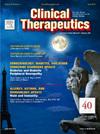New Approach Combination-Dosed Therapy for Nonalcoholic Steatohepatitis Versus Vitamin E: A Randomized Controlled Trial
IF 3.6
4区 医学
Q2 PHARMACOLOGY & PHARMACY
引用次数: 0
Abstract
Purpose
There is currently no US Food and Drug Administration–approved remedy for nonalcoholic steatohepatitis (NASH). The present study evaluated the efficacy of N-acetyl cysteine (NAC) and rosuvastatin (RSV) compared with conventional vitamin E in patients with NASH.
Methods
This study was designed as a parallel, double-blinded, randomized controlled trial. Ninety patients who met the eligibility criteria were enrolled in this study. Subsequently, 45 patients were allocated to each group as follows: group 1 reported consistent administration of vitamin E 400 IUⓇ (PHARCO-Pharmaceuticals) twice daily over a duration of 6 months. Group 2 included patients with NASH who received NAC, Gemacysteine 300 mgⓇ (GEMA-Pharma) at 1200 mg twice daily, along with RSV, Crestor 20 mgⓇ (AstraZeneca). To achieve the study’s objective, FibroScanⓇ examination of liver tissue and fibrosis scores, as well as tests for liver aminotransferases, lipid profile, glycemic parameters, and hepatic and renal functions, besides health-related quality of life using the Short-Form 36 were evaluated before and after 6 months of treatment.
Findings
In group 1, a statistically significant decrease in the mean value of steatosis was observed after 6 months by 6.05% (P = 0.017), whereas treated group 2 exhibited a reduction of 16.49% (P = 0.001). Group 2 reported a statistically significant decrease in the mean fibrosis value of approximately 19.5% (P = 0.001). Fibrosis-4 Index score’s significance stated a reduction in the mean values within treatment group 2, with decreases of 51.70%. MACK-3 score which is a combination of homeostatic model assessment, aspartate aminotransferase, and cytokeratin-18, exhibited a notable reduction in mean values within treatment group 2 by 25.06% (P = 0.001). Concerning biological markers, malondialdehyde, both groups reported significant reductions in mean values of 11.90% (P = 0.006) and 27.43% (P = 0.001), respectively. Group 2 exhibited substantial reductions in mean levels of all biological markers: NOD-like receptor-associated protein 3 inflammasome decreased by 24.40%, tumor necrosis factor-α by 9.64%, tissue inhibitor of metalloproteinases 1 by 10.28%, N-terminal propeptide of procollagen type III by 14.58%, cytokeratin-18 by 23.44%, and fibroblast growth factor-21 by 15.08% (P < 0.05), whereas group 1 did not demonstrate significant differences. Group 2 has substantial improvement in various metabolic parameters and health-related quality of life with accepted safety profile parameters.
Implications
Patients in group 2 treated with the combination of NAC/RSV exhibited tolerability and efficacy in improving liver steatosis and fibrosis, besides metabolic parameters, indicating a new combination approach to the management of NASH. ClinicalTrials.gov identifier: NCT06105060.
非酒精性脂肪性肝炎与维生素E联合治疗的新方法:一项随机对照试验
目的:目前还没有美国食品和药物管理局批准的治疗非酒精性脂肪性肝炎(NASH)的药物。本研究评估了n -乙酰半胱氨酸(NAC)和瑞舒伐他汀(RSV)与常规维生素E在NASH患者中的疗效。方法:采用平行、双盲、随机对照试验。90名符合资格标准的患者参加了这项研究。随后,45名患者被分配到每组如下:1组报告连续服用维生素E 400 IUⓇ(PHARCO-Pharmaceuticals),每天两次,持续6个月。第2组包括NASH患者,接受NAC, Gemacysteine 300 mgⓇ(GEMA-Pharma),剂量为1200 mg,每日两次,同时接受RSV, Crestor 20 mgⓇ(阿斯利康)。为了实现研究目标,在治疗前和治疗后6个月评估了FibroScanⓇ对肝组织和纤维化评分的检查,以及肝脏转氨酶、血脂、血糖参数和肝肾功能的测试,以及使用Short-Form 36的健康相关生活质量。结果:1组患者6个月后脂肪变性的平均值下降了6.05% (P = 0.017),而2组患者6个月后脂肪变性的平均值下降了16.49% (P = 0.001)。2组平均纤维化值下降约19.5%,具有统计学意义(P = 0.001)。纤维化-4指数评分的显著性表明治疗组2内的平均值降低了,降低了51.70%。由稳态模型评估、天冬氨酸转氨酶和细胞角蛋白-18组成的MACK-3评分显示,治疗组2的平均值显著降低了25.06% (P = 0.001)。关于生物标志物丙二醛,两组分别报告了11.90% (P = 0.006)和27.43% (P = 0.001)的均值显著降低。2组患者所有生物标志物的平均水平均显著降低:nod样受体相关蛋白3炎性小体下降24.40%,肿瘤坏死因子-α下降9.64%,金属蛋白酶组织抑制剂1下降10.28%,III型前胶原n端前肽下降14.58%,细胞角蛋白-18下降23.44%,成纤维细胞生长因子-21下降15.08% (P < 0.05),而1组无显著差异。2组在各种代谢参数和健康相关生活质量方面有显著改善,并具有公认的安全性参数。意义:第2组患者接受NAC/RSV联合治疗,除代谢参数外,在改善肝脏脂肪变性和纤维化方面表现出耐受性和有效性,表明一种新的联合治疗NASH的方法。临床试验:gov标识符:NCT06105060。
本文章由计算机程序翻译,如有差异,请以英文原文为准。
求助全文
约1分钟内获得全文
求助全文
来源期刊

Clinical therapeutics
医学-药学
CiteScore
6.00
自引率
3.10%
发文量
154
审稿时长
9 weeks
期刊介绍:
Clinical Therapeutics provides peer-reviewed, rapid publication of recent developments in drug and other therapies as well as in diagnostics, pharmacoeconomics, health policy, treatment outcomes, and innovations in drug and biologics research. In addition Clinical Therapeutics features updates on specific topics collated by expert Topic Editors. Clinical Therapeutics is read by a large international audience of scientists and clinicians in a variety of research, academic, and clinical practice settings. Articles are indexed by all major biomedical abstracting databases.
 求助内容:
求助内容: 应助结果提醒方式:
应助结果提醒方式:


